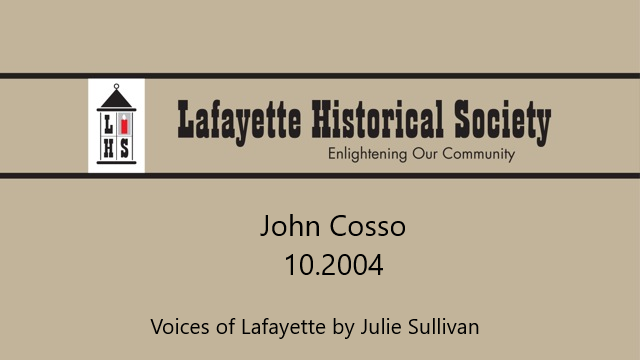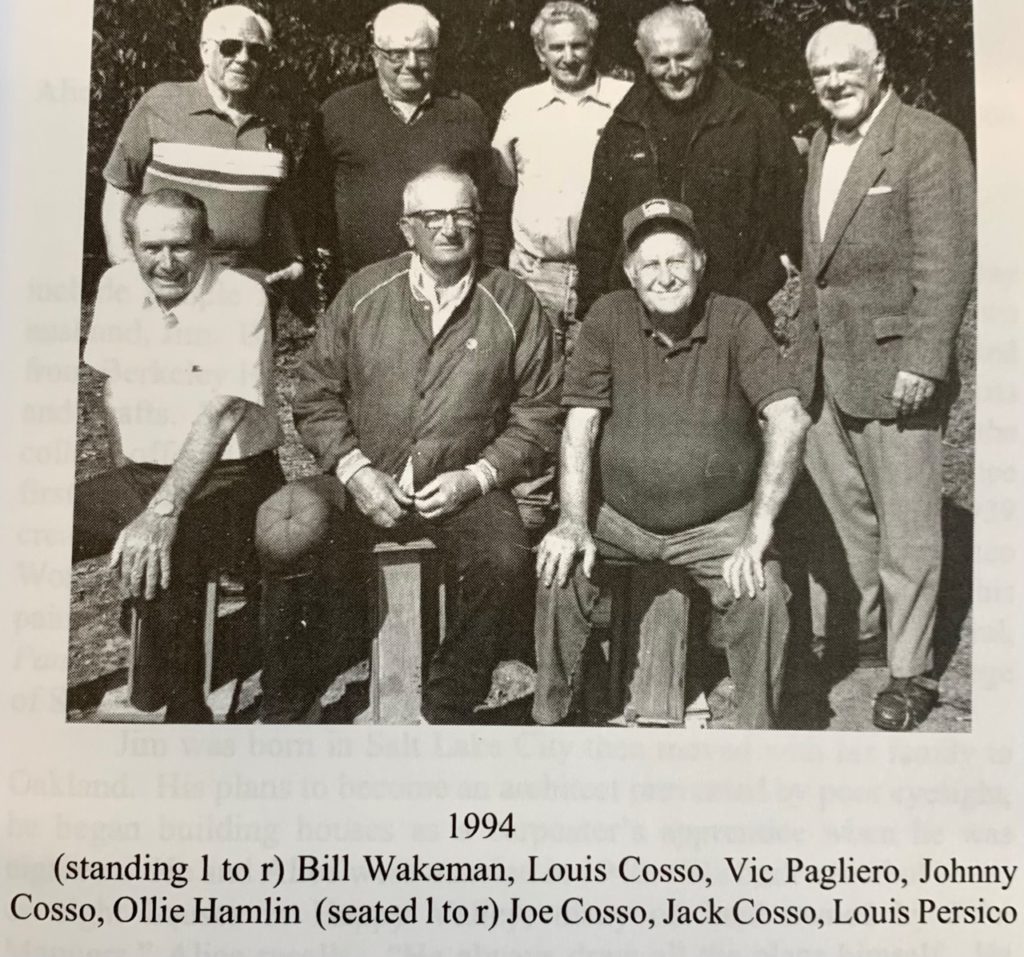Summary:
John Cosso was interviewed by Julie Sullivan in October, 1994. John’s uncle, who had emigrated from Genoa, Italy, bought 55 acres in Happy Valley in 1920. Members of his family operated a truck farm for almost thirty years, after which they sold most of the land to developers who built homes. Individual lots were retained for the personal residences of John and his five brothers and sisters. In this interview John discusses the changes he observed in the town during his 65 years as a Lafayette resident.
Oral History:
John Cosso doesn’t have to search for history – he’s living in it. He and his wife reside in the original Cosso homestead at 21 Cosso Court near Happy Valley School that his family bought in 1920.
Candido Cosso came to California from Genoa, Italy. He raised vegetables in Alameda before buying fifty-five acres in Lafayette. He and his wife Ceelestina had only been living in Lafayette a few years when Candido died after being thrown from a horse-drawn wagon, leaving his pregnant wife with four children. His brother, Nicola, had just arrived from Italy and helped Ceelestina run the ranch. Seven years later they were married, and John was born in 1929.
John, youngest of the six Cosso children, says, “We never considered ourselves step-anything. We were brothers and sisters. All my dad did was truck farming. In the Depression survival was based on what you could grow on the farm. You had the cow and the chickens and the produce you grew.
“People can’t believe it now when they see pictures of what our land up there looked like. We used to plant hay and harvest it and run horses and cattle, and they kept it clean. On the sides of the hills we used to grow vegetable crops. When you come over Deer Hill Road today from Acalanes and look over Lafayette all you see is trees. When you came over in the old days it was just a clear valley, and you could see every building. Now people see a forest.”
John started school in 1936 at the old Lafayette Elementary School and took religious instruction classes in the basement of the Town Hall. The closest Catholic church was in Walnut Creek. After graduating from Acalanes High School in 1947, John served in Korea. “Until I went into the service, my parents were still truck farming up there on Happy Valley Road. My dad sold thirty-seven acres on the other side of Happy Valley Creek to Russ Bruzzone in 1948 or 49. Russ also purchased approximately eleven acres from my dad where the school sits now. When my dad sold the thirty-seven acres, he got enough to pay off the mortgage on the land. The initial cost for fifty-five acres was $22,000 in 1920.”
After John returned from Korea, he married Rosemary Arecco of Oakland in 1952. They have five children living in the Bay Area. John worked in the garbage removing industry in Oakland from 1952 to 1992, when he retired.
“By the time I came back, the farm was all sold except for a six- acre parcel. My oldest sister and I each developed an acre. I built a house with my wife at 3873 Happy Valley Road in 1956. My father had a little money, and he financed me up front. I eventually paid him off.
“In 1966, my sister developed a home for her family on another acre. My mother passed away in 1967, and my dad lived in the family home until he passed away in 1979. When he died, the six remaining acres were willed one acre to each child. Nobody else seemed interested in the homestead, because it was kind of run down. I said I would take that lot, then we drew numbers out of a hat for the other five lots. None of the kids were living on the property except for me and one sister at that time. That’s when we developed Cosso Court. My wife and I remodeled the homestead. We left the house we’d built in 1956 and moved back into the homestead in 1982. Our daughter moved into our old house. I still fool around up there and plant a few tomatoes and onions and some corn.”
John remembers Lafayette as “a very quaint town. Highway 24 was Tunnel Road before they renamed it State Highway 24. Mt. Diablo Boulevard is basically the old Tunnel Road. The only veer they made in it is when you get to the Hungry Hunter. You have to go right then pick up Tunnel Road again. I think it used to curve down there where Blodgett’s is. I remember the Cape Cod and Danny Van Allen’s restaurant. Then there was the Tunnel Inn right across the street from where the Roundup is now. I remember Thomson’s Blacksmith Shop. We used to go in there and get wagon wheels fixed and horseshoes made up. We used horses on the ranch when I was in high school. I remember coming home with a sprained ankle playing football and having to cultivate behind the horse, because I didn’t want to tell my father.
“I remember Bill’s restaurant (Ed Bill was the son, we called him Dutch) right on the corner where World Savings (now Wachovia) is. It was a dinner house. A husband and wife ran it. The Flying A gas station was in the front, and part of their back parking lot was the front lot for Bill’s restaurant. The Roundup was there, and as you came up, I remember Jensen’s Hardware Store. Jensen’s was where Chico’s is. On the corner where Starbucks is there used to be Stark’s Market. I believe there was a little soda fountain in there.
“The Community Church was just a one-room building, and prior to that it was the school. My brother, Jack, went to school there. Mt. Diablo Boulevard was pretty quiet. As you came west, Ed Morrison had his fire house just west of where the Roundup is now. They used to wheel the fire truck out for parades now and then. There was a gas station on either corner of Dewing, one of them a Shell station. Across the street was Petar’s under the big eucalyptus tree. Freddie’s Pizza was in the brick building, but that came quite a few years after.
“Heading west, where the Jewish Temple is now, was a restaurant called Planter’s Dock. As you went further west on Tunnel Road there was the El Nido Rancho restaurant and motel. That was all watershed land with the reservoir across the street.
“Diamond K has been there for many years, and across the street I think was Lafayette Lumber and Hardware. They had a pretty-good- sized shed there, and Bob Wing’s father had a car repair shop for Model A’s, Model T’s and little old Chevys. Gus Silva took it over after him.”
In the 1920’s, John says there were basically three ethnic groups in Lafayette, “The Portugese, the Italians and the Japanese. The Portugese ran dairy and cattle farms, and the Italians and Japanese were into truck gardening. The Fegundas, the Mechados and the Soares were Portugese. They were up at the top of Happy Valley Road The Mucanos and the Takashis were Japanese. The industry here was agriculture.
“I always thought Lafayette was a great place. Today it’s a little bit hectic and confusing and congested, but I still find it great. The major changes were the chain grocery stores coming in, BART coming through, and Highway 24.
“It wasn’t much fun going up over the top of either Fish Ranch Road or Old Tunnel Road before the Caldecott Tunnel opened,” John remembers. “My father used to go by horse and wagon over the top to peddle produce and pick up supplies on the way back. When they punched the tunnels through in 1937, that just opened up the area. Pretty soon, Super Saver Market popped up where Longs is now, and Bill’s Drugs opened where Round Table Pizza is now.
“Lafayette’s not a suburb any more. We have hustle and bustle of our own, and it wasn’t that way into the 60’s or even 70’s. We had Marchant and Osmond and Bruzzone building and developing, but it still wasn’t too urban. If you’re a quarter of a mile away from Mt. Diablo Boulevard it’s still kind of suburban. You realize you’re in a more densely populated area when you get hung up when all the mothers are dropping their kids off, or when you go to the post office.”
John misses the tranquility when he was younger. “I still look back and kind of cherish that period in my life even though at the time I probably didn’t appreciate it. The lifestyle I was leading as a boy and young adult was more independent. Even in 1968 when Lafayette incorporated, that really didn’t thrill us, because we felt we weren’t going to realize any tremendous benefit. We never had any problem with the county. They maintained our roads, and we didn’t have much need for policing. I can remember never locking our doors. I basically miss that era, but I’m not uncomfortable the way things are now. I’ve adjusted to it.
“We didn’t worry about a neighbor saying your tree is dropping leaves in my swimming pool. We were simple, and now we’re more sophisticated. I’m not saying if it had continued the way it was when I was born, I would be living better. I would be more lonely.”
This interview is excerpted from Voices of Lafayette, by Julie Sullivan. This book is available for purchase in the History Room.



Leave a Reply